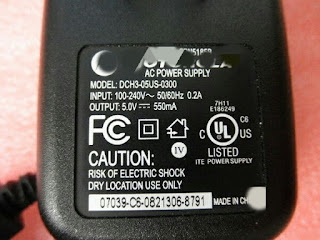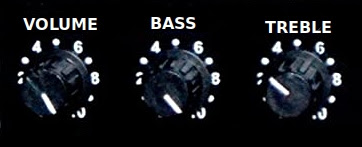MEASUREMENT OF RESISTANCE USING COLOR CODE
 |
| Carbon resistor |
COLOR CODE:
In this coding system colors are coded as 0,1,2,3,.....8,9.
First, we know the color and its code then we learn how to calculate the resistance seeing the color printed on carbon resistor.
To remember this you can use this mnemonic -| Color | Code |
| Black | 0 |
| Brown | 1 |
| Red | 2 |
| Orange | 3 |
| Yellow | 4 |
| Green | 5 |
| Blue | 6 |
| Violet | 7 |
| Gray | 8 |
| White | 9 |
Black Bro Resident Of Your Greenland Become Very Good Wicketkeeper .
the bold capital letters represent the color Black, Brown, Red, Orange, Yellow, Blue, Violet, White respectively.
Now we learn how to calculate the resistance of a resistor using color code:
Each resistor is provided 3 or 4 color band. The position of color band is shown in the adjacent diagram. The first band is closer to the edge.
 |
| schematic diagram of color band on resistor |
Resistor having 4 color band:
If the resistor have 4 color band -
- The first two color band (closer to the edge ) represents the first two digit os resistance.
- The 3rd color band represents the number of zeros to be pit after the first two digits.
- The 4th color band represents the tolerance ( in percentage) .
Actual resistance of the resistor do not exact same as the calculated result. The amount by which the actual resistance can differ from the color code value is called tolerance.
Gold in 4th color band indicate a tolerance ± 5%
Silver in 4th color band indicate a tolerance ± 10%
EXAMPLE:
Here, the resistor has 4 color band.
1st is Orange (3)
2nd is Blue(6)
3rd is Brown (1)
4th is Gold
Therefore, the resistance of the resistor is 360 ohm and tolerance is ± 5%.
Tolerance is ± 5% mean that the actual value of resistance may not be 360 Ω but it is confirm that the actual value is lying between 342 Ω ( -5% of 360 ohm) to 378 Ω( +5% Of 360 ohm).
Silver in 4th color band indicate a tolerance ± 10%
EXAMPLE:
Here, the resistor has 4 color band.
1st is Orange (3)
2nd is Blue(6)
3rd is Brown (1)
4th is Gold
Therefore, the resistance of the resistor is 360 ohm and tolerance is ± 5%.
Tolerance is ± 5% mean that the actual value of resistance may not be 360 Ω but it is confirm that the actual value is lying between 342 Ω ( -5% of 360 ohm) to 378 Ω( +5% Of 360 ohm).
Resistor having 3 color band:
- If the resistor have 3 color band and the 3rd band is Gold or Silver the resistance of that resistor is below 10 ohm.
- The first two (closer to the edge ) color band represent the first two digit of the resistance.
- 3rd color band represents the fractional decimal multipliers.
When the 3rd band is Gold the first two digit is to be multiplied by 0.1
When the 3rd band is Silver, the first two digit is to be multiplied by 0.001
EXAMPLE:Suppose, the color band are Brown (1), Green (1), Gold .
The resistance of the resistor = 15* (0.1) Ω = 1.5 ohm
- If the resistor have 3 color band but the 3rd band is not Gold or Silver ( i.e 3rd band is the one of the colors of Black, Brown, Red, Orange, Yellow, Green, Blue, Violet, Gray, White) , the value of the resistance is to be calculated as 4 band resistor. In this case the tolerance is ±20% .
Available resistance:
A resistance of any arbitrary value is not available in the market. Only certain fixed carbon resistors are manufactured in large quantities. As a result they become cheaper and easily available.
- Available resistors of 20% Tolerance are -
10,15,22,33,47,68 ohms and their decimal multiples (i.e 0.1, 10, 100, 1000 etc.) - Available resistors of 10% Tolerance are- 10, 12, 15, 18, 22, 27, 33, 39, 47, 56, 68,82 and their decimal multiples ( i.e 1.2, 12, 120, 1200 etc.)
Following is the list of commercially available resistors of ±10% tolerance:
Ω
|
KΩ
|
MΩ
|
|||||
1.0
|
10 | 100 | 1.0 | 10 | 100 | 1.0 | 10 |
| 1.2 | 12 | 120 | 1.2 | 12 | 120 | 1.2 | 12 |
| 1.5 | 15 | 150 | 1.5 | 15 | 150 | 1.5 | 15 |
| 1.8 | 18 | 180 | 1.8 | 18 | 180 | 1.8 | 18 |
| 2.2 | 22 | 220 | 2.2 | 22 | 220 | 2.2 | 22 |
| 2.7 | 27 | 270 | 2.7 | 27 | 270 | 2.7 | |
| 3.3 | 33 | 330 | 3.3 | 33 | 330 | 3.3 | |
| 3.9 | 39 | 390 | 3.9 | 39 | 390 | 3.9 | |
| 4.7 | 47 | 470 | 4.7 | 47 | 470 | 4.7 | |
| 5.6 | 56 | 560 | 5.6 | 56 | 560 | 5.6 | |
| 6.8 | 68 | 680 | 6.8 | 68 | 680 | 6.8 | |
| 8.2 | 82 | 820 | 8.2 | 82 | 820 | 8.2 | |




This comment has been removed by the author.
ReplyDeleteit is very useful device MESUREMENT OF RESISTANCE USING COLOR CODE
ReplyDeletetechnology guest post
Great post. I was once checking constantly this weblog and I'm impressed! Extremely useful information specially the closing part. I maintain such information much. I was once seeking this specific information for a very long time. Many thanks and best of luck. For more details: https://iiot-shop.com/
ReplyDeleteI just found this blog and have high hopes for it to continue. Keep up the great work, its hard to find good ones. I have added to my favorites. Thank You. For more details: http://www.generatingsolutions.net/
ReplyDeleteNice article. It's very helpful to me. Thank you for share with us. Can you please check my color code collection.
ReplyDeleteVery good post.
ReplyDeleteAll the ways that you suggested for find a new post was very good.
will help you more:
There is a lot of information related to science related to our site. Please visit our site to find known and unknown information about science:
essay writing service
Thanks for sharing this blog .It's Very Usefull for me.
ReplyDeleteTrutech Product is the leading Transformer Manufacturers in Pune at the best cost visit us for:
Transformer Manufacturers In Mumbai
Transformer Manufacturers In India